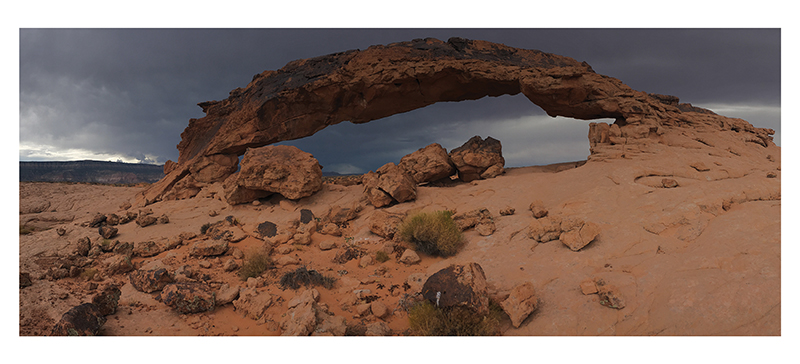
Voices of the Arches: Displacing Vibrations at Nox Contemporary
Art
On Friday, Feb. 15, 2019, Nox Contemporary presented the multi-media exhibition Displacing Vibrations by visual and performance artist Wendy Wischer, in collaboration with geophysicist Jeffrey Moore.
Displacing Vibrations is a direct response to 45’s administration shrinking the boundaries of the Bears Ears and Grand Staircase–Escalante National Monuments. “Less than a political statement, our aim is to raise awareness that these features exist, and that they deserve and need our assistance to ensure their long-term preservation,” says Moore. “These arches are like nothing else on earth, found in such density and variety nowhere else on earth—that is a resource worth protecting.”
To gather the data that Wischer used to create a visual and experiential exhibition, Moore and University of Utah PhD students Paul Geimer and Riley Finnegan spent years creating a methodology that would allow them to measure the sounds of rock formations. “Starting the project several years ago, we had no idea if we could even measure the resonant frequencies of natural rock arches from ambient vibration data,” Moore says. “We were pleasantly surprised, as arches are powerful and clean resonators producing clearly distinct, resonant tones.”
The geology team’s study used broadband seismometers—similar to those used to record earthquakes—placed on an arch for anywhere between one and 24 hours. They recorded continuous vibrations and then processed data for their frequency content. The seismometers are small, about the size of a coffee can, and simply rest on the arch, which means that this method is completely noninvasive and nondestructive.
Each piece in the exhibition is closely connected to the next. Visitors can expect a number of interactive, nontraditional installation pieces both in 2D and 3D. “One piece in the show is a chalk drawing directly on the wall accompanied by erasers, inviting the viewers to erase it but without providing any chalk, so adding to it is not an option,” says Wischer. “The piece is intended to comment on temporality and loss. Others are laser-cut collages from digital drawings out of mirror acrylic and mounted on white acrylic that consist of former and current borders of the national monuments, however, these borders also hold the potential for shifting.”
Visitors can also expect various sound pieces, influenced or directly taken from the vibrational sounds from Moore’s study. In a separate, small room filled with a sculptural sandstone landscape, there exists a 45-minute sound sculpture with a high-tech subwoofer hidden under the rock formations. The sound sculpture contains vibrations from those onsite recordings after they have been modified with speed and amplification. “Viewers are allowed to touch the rock sculptures to feel the vibrations as well as gently sit on a sculptural arch that is part of the piece,” Wischer says. “The sound sculpture is both felt and heard.”
Wischer often uses her creative research to highlight environmental issues, translating data into personal understanding and creating artwork that moves the viewer in poetic ways. “Partnering with an artist like Wendy Wischer pushes us to think differently about our data and subject, and brings an emotional component to our work that is not typical for day-to-day science,” Moore says. “Wendy helps translate scientific data into something that people can experience and relate to broadly—scientists are pretty often bad at this.”
Moore believes that the spiritual and personal connection of this exhibition creates even more value than the data itself. “We initially thought there may be some scientific value helping us interpret these vibrations—rather, we’ve found that hearing the hum of the rock creates a meaningful experience for people, allowing them to connect with precious landscapes and features in a new, dynamic way,” says Moore. “We hope it inspires curiosity and a sense that these features are sensitive and fragile and need protecting.”
Creative and critical partnership between the arts and sciences, like with his partnership with Wischer, might be the key to raising awareness and protecting public lands, Wischer says. “Addressing our increasing global-climate crisis demands new ways of thinking and perceiving to find solutions to the ever-increasing problems we face,” she adds. “Interdisciplinary research between the arts and sciences holds the potential for informing new pathways of exploration and understanding, creating a beneficial flow in both directions.”
Ultimately, the installation, while overtly about ownership, stewardship and borders, is also about connection with the Earth. Wischer says, “I seek a wide range of information that can be used creatively to link nature with technology, science with mythology, and personal identity with universal connections in hopes of finding impactful ways to connect people more deeply with the environments they live in and with each other.”
Moore’s team is supported by a grant from the National Science Foundation and Displacing Vibrations was generously funded by the College of Fine Arts Faculty Research Grant at the University of Utah. Displacing Vibrations is open to the public by appointment at Nox Contemporary from through April 5, 2019. To make an appointment, contact Nox curator John Sproul by call or text at 801.289.6268. Nox is located at 440 S. 400 West, Ste. H, in Salt Lake City. Displacing Vibrations is also open during gallery stroll on March 15 from 6 to 9 p.m., with a the closing reception on March 15.